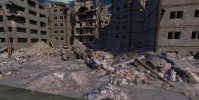I wonder why the two games Bunnell worked on never released.Not many usage of GI surfel in videogame
https://cgg.mff.cuni.cz/~jaroslav/gicourse2010/giai2010-05-michael_bunnell-slides.pdf
His idea is really outstanding, as it replaces the visibility term with a cheap approximation, reducing (brute force) cost of a sample from N^2 to N. It's the only proposed GI method i know which achieves a serious speedup.
Though, at a high cost. The shifting / leaking errors make it inpractical for indoor in my experience, and proposed grouping is just a hack but no fix. But for outdoor games this would be still interesting IMO.
Somewhat sad. Feels like a lost opportunity. Maybe the patent on the algorithm is an issue.


